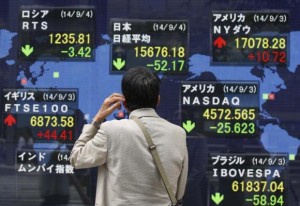
A man looks at an electronic board displaying Japan’s Nikkei average (top C) and the stock price indexes of various countries outside a brokerage in Tokyo September 4, 2014.
Credit: Reuters/Issei Kato
TOKYO
(Reuters) – Asian shares were poised to end the week on a sour note on Friday after a steep drop on Wall Street, while the dollar steadied close to multi-year highs touched in the previous session.
U.S. stocks ended sharply lower, as Apple Inc broke under key technical levels after the tech giant withdrew an update to its new operating system. That pushed the S&P 500 to its biggest one-day decline since July.
MSCI’s broadest index of Asia-Pacific shares outside Japan .MIAPJ0000PUS slumped 0.7 percent, poised for a weekly loss around 2.6 percent.
Japan’s Nikkei stock average skidded 1 percent, on track for a weekly loss. Data released before the market opened showed Japan’s annual core consumer inflation eased in August, in another sign that the Bank of Japan could be forced into additional easing steps to meet its 2 percent price goal sometime next fiscal year.
The dollar index .DXY, which tracks the greenback against a basket of major currencies, edged up about 0.1 percent to 85.260, after it rose to a four-year high of 85.485 on Thursday.
The dollar is on track for its 11th successive weekly rise, something it has not achieved in four decades.
“At the moment, the economy with strong business sentiment is that of the United States… The dollar is becoming the destination of funds that are escaping stimulus elsewhere,” said Daisuke Uno, chief strategist at Sumitomo Mitsui Bank.
The yield difference between 10-year U.S. Treasuries and German Bunds was at its widest in nearly 15 years on Thursday, putting pressure on the euro.
The European unit edged down slightly on the day to $1.2746, after falling as low as $1.26955 on trading platform EBS on Thursday, its lowest since November 2012.
The dollar was about 0.2 percent higher on the day against its Japanese counterpart at 109.02 yen, though still shy of a six-year peak of 109.46 climbed a week ago.
Brent crude LCOc1 was slightly down on the day at $96.97 a barrel, set for its third weekly fall in four, as hefty supplies capped price gains and offset concerns that rising tensions in the Middle East could disrupt supply.
Spot gold was steady at $1,223.90 an ounce, after rebounding off Thursday’s session low of $1,206.85 an ounce, its weakest since Jan. 2. It looked set to snap a three-week losing streak on weaker equities, but dollar strength kept it in danger of breaking below the key $1,200-an-ounce level.
(Additional reporting by Hideyuki Sano in Tokyo; Editing by Eric Meijer & Shri Navaratnam)







